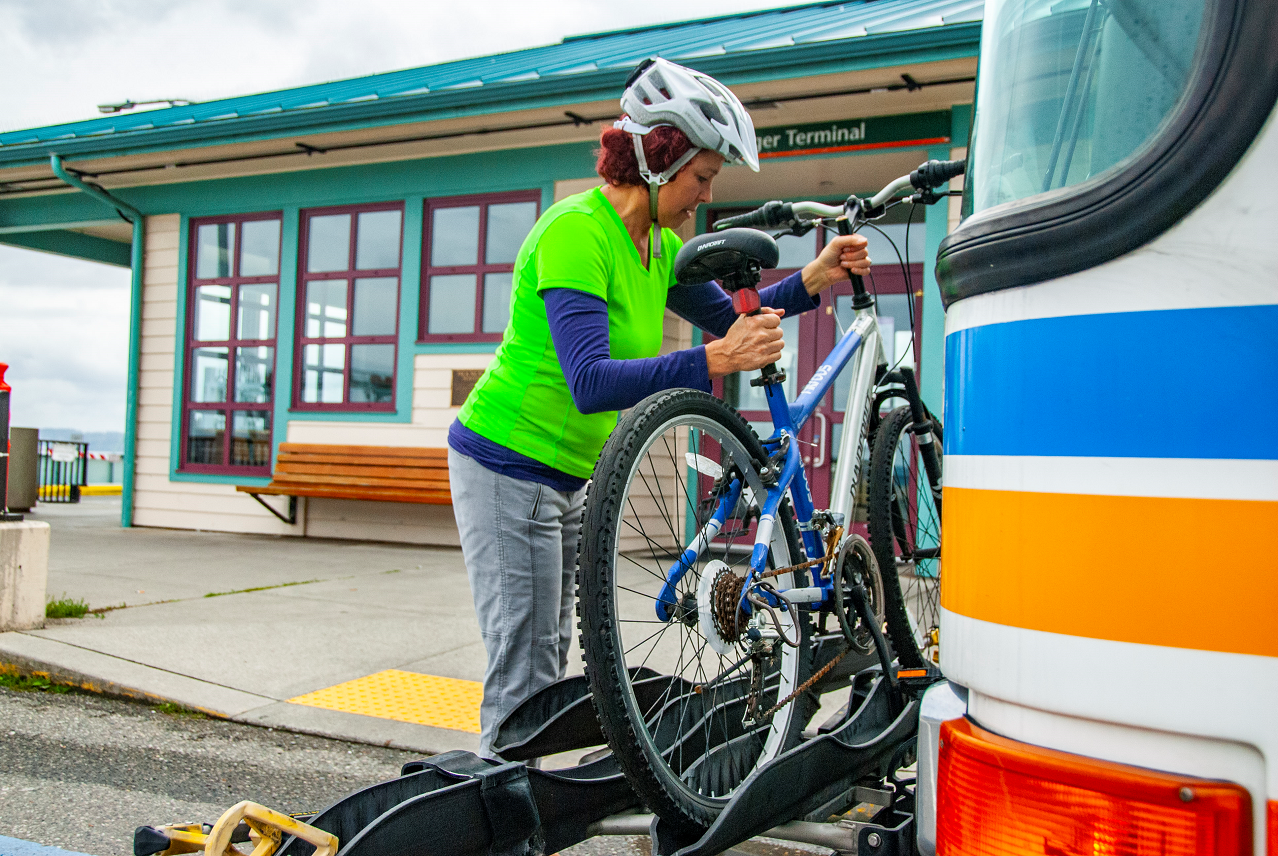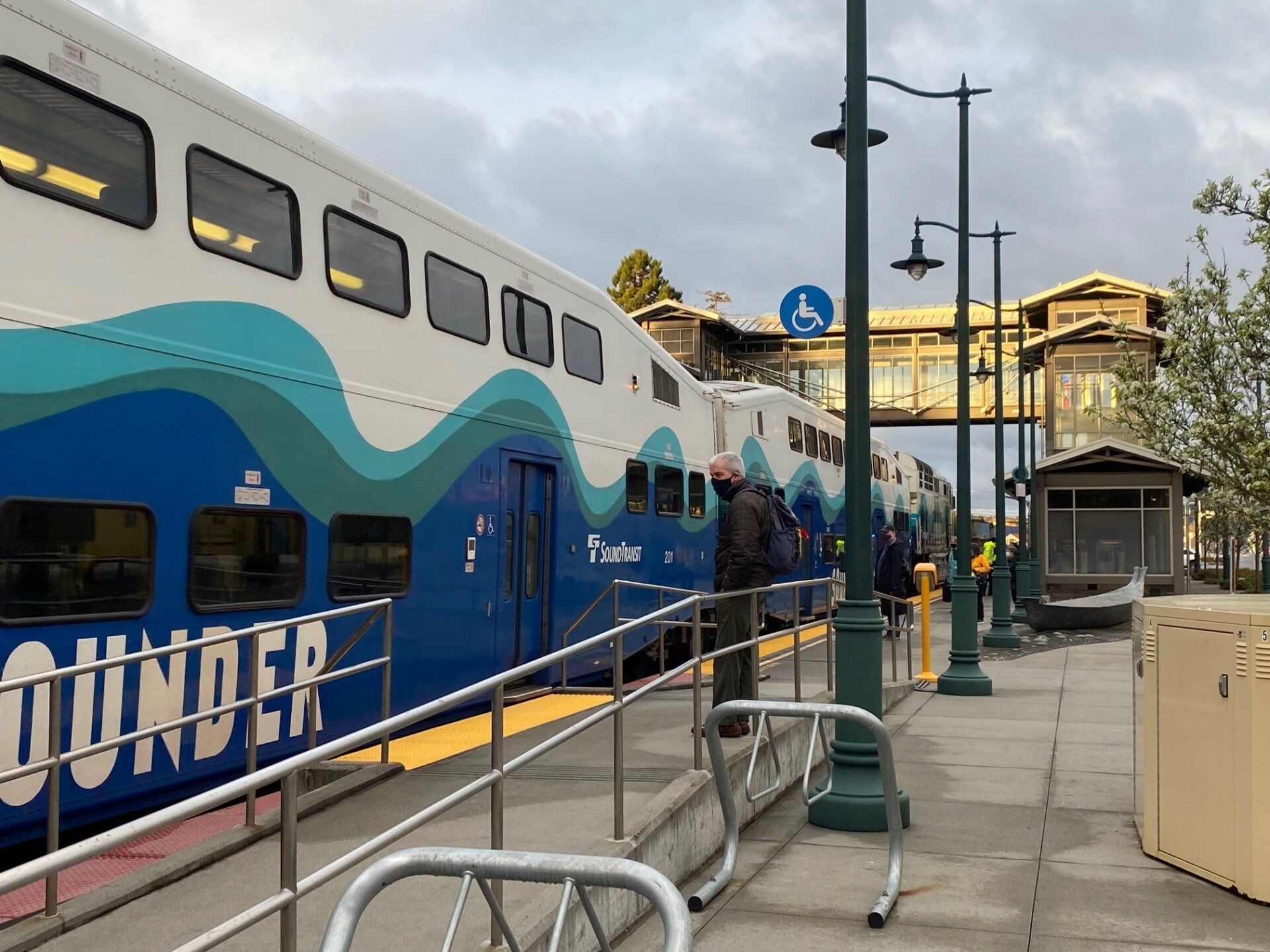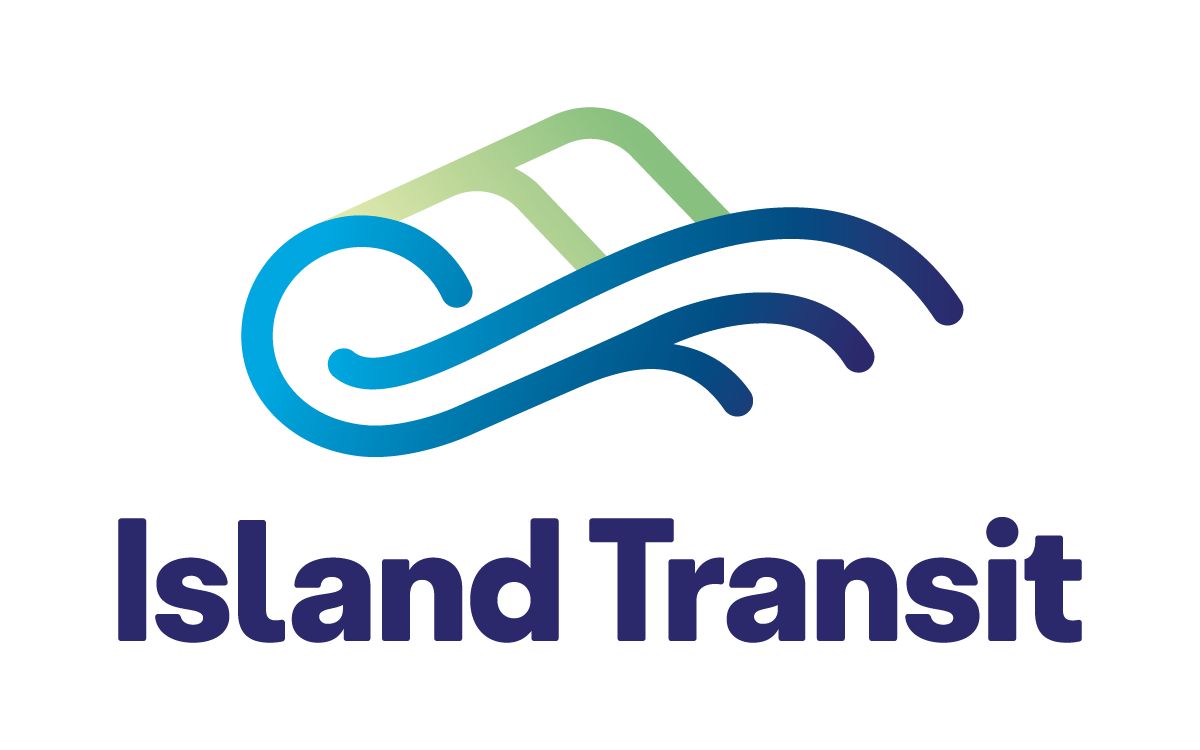> HOW TO RIDE THE BUS
Just hop on and go!
New to riding the bus? Island Transit offers both fixed route (bus stops that are marked) and flag stops (unmarked spots along the route that are safe for the bus to pull over completely out of the road) services.
Riding the bus may seem a bit scary for someone who has never ridden the bus - we understand - so we make it as easy as possible. Riding the bus is free in Island County, our dispatchers are always ready to help answer questions or help plan a route, and all bus drivers are friendly and knowledgable.


-
Is the bus really free?
Yes.
Island Transit has been a fare-free bus system since its founding in 1987. You don’t need a ticket, cash or coins to ride the bus, which makes bus transportation a very easy and convenient way to travel around Island County. Just hop on and go.
Bus service is funded through 9 tenths of 1% of Island County's local sales tax and supplemented by state and federal grants. So, support public transit and shop local!
-
I've never ridden the bus. How do I plan a trip?
First, decide your:
- Starting Point. Where will you get on the bus?
- Destination. Where do you want to go?
- Arrival Time. When do you want to arrive at your destination?
- Find your bus route!
We provide several ways to look at routes and schedules:
Google Trip Planner instantly maps your route. Enter your “Start Address” and “End Address”, along with the date and approximate time you would like to arrive at your desired destination. Press “Get Directions” and the Trip Planner will provide you with the route number of the bus, departure and arrival times, and travel time in minutes.
Island Transit Service Guides contain maps and schedules for all routes on Whidbey and Camano islands. You’ll find our guides at ferry terminals, bus stations, with tourist information, and on the bus. Check the date on the guide to make sure you’re using the current issue. See “How to Read a Schedule” below for a short tutorial on how to use the printed guide.
Island Transit Customer Service is available to help plan your trip. For trip planning on Whidbey Island, call (360) 678-7771. For trip planning on Camano Island, call (360) 387-7433. You can also email us at info@islandtransit.org.
-
How do I catch the bus?
You may catch the bus at any bus stop, shelter or transit center along Island Transit routes. Or, if safe and you are on an established bus route, flag down the bus. Here are some tips for catching the bus:
- Please arrive at least five minutes early for scheduled stops.
- Some bus stop posts have a button on it. Push the button, but only when you see the bus approaching. The button activates a flashing light at the top of the post and alerts the driver that a rider is waiting. A friendly wave also is welcome.
- Check the sign across the top of the front of the bus to confirm you’re getting on the route you want. Some bus stops are served by more than one route.
- If you are at a shelter, please stand at the front of it and wave as the bus approaches.
- If you are flagging the bus to stop, be sure to stand where the driver can see you from a distance.
-
What is a flag stop?
A flag stop is when a rider boards the bus at a location that is not an established bus stop with a posted bus stop sign. The driver has discretion to stop the bus to pick up or drop off passengers at any location requested by a rider, as long as it is safe.
Keep in mind, there are potential safety concerns about stopping at certain spots in Island County.
As the bus approaches, raise and lower your arm over your head several times to catch the driver’s attention. Be sure to stay back from the edge of the road to allow the bus enough room to pull off. During dark or foggy weather we suggest you have a flashlight that you can wave for the driver to see you.
A list of stops that Island Transit will not service due to safety reasons is found here. This list rarely changes, but you may want to confirm with us.
-
How do I signal the driver to get off the bus?
Our buses have either a cord along the windows to pull or a yellow strip between the windows to push to notify the driver that you’re approaching your stop. Depending on the bus, pull the cord or push the yellow strip when you wish to get off the bus. A red Stop Requested light at the front of the bus notifies the driver that you wish to get off the bus. You can also use a loud and clear voice to politely tell the driver where you want the bus to stop.
-
If I'm not sure where and when to get off the bus, may I ask the operator for help?
Yes. If you’re a new rider or going to an unfamiliar location, it’s a good idea to tell the driver where you want to go as you board the bus. The bus driver can help you find your stop. They also can call ahead to help you make connections with another bus if needed.
-
What are the current Safety and Health Guidelines for riding the bus?
We updated our Safety and Health Guidelines in response to the pandemic. Please observe the following to protect all onboard:
- Do not travel if ill.
- Wear a face covering on the bus. If you don’t have one, we provide face masks so that all passengers are protected.
- Use the hand sanitizer provided on all of our buses if needed.
- Do not eat on the bus. If you bring a (non-alcoholic) beverage, it must have a tight-fitting lid.
- Smile for the cameras! They are located on our buses for your safety, comfort and security.
- Riders acting inappropriately, may be asked to leave.
We have implemented temperature and health check procedures when entering our buildings, provide our operators with protective gear, including protective barriers on the buses, perform daily hydrostatic disinfecting of buses and employee common areas, and began retrofitting our buses with an Air Filtration System.
Read Frequently Asked Questions about Health and Safety operations during COVID-19.
-
What other procedures and rules should I follow?
Do:
• Remove children from strollers before boarding the bus. Collapse strollers and store securely.
• Keep all bags, strollers, shopping carts, and other belongings out of the isles of the bus at all times.
• Accompany children under 6 years of age and keep them seated at all times to ensure their safety when the bus is moving.
• Let the bus driver know you need to remove a bicycle from the bike rack before leaving the bus.
• Wear a shirt, shoes and face covering.
• Maintain personal hygiene.
• Wait until the bus pulls away after disembarking and use the crosswalk to cross the street. Never cross in front or directly behind the bus.
• Use cell phones and other devices quietly, so as not to disturb others. Earbuds are recommended.
Don’t:
• Smoke or vape within 25 feet of Island Transit property.
• Eat on the bus or drink from a cup without a secure lid. Alcohol is prohibited on all vehicles.
• Bring flammable or corrosive items or liquids onboard.
• Partake in loud or disruptive behavior.
• Play loud music from radios, earbuds or headphones.
• Carry more than you can lift within one trip (4 grocery bags or 1 cart).
Behavior that May Result in Loss of Bus Privileges:
• Unruly, disrespectful behavior.
• Use of profanity or derogatory statements including racial slurs.
• Intimidating, harassing or violent behavior.
• Excessive body odor.
-
Are the buses accessible for people living with disabilities?
Yes.
- When the bus arrives, please stand back for a moment. There may be riders on the bus that need to disembark before you board.
- If you need a ramp or lift to board the bus, just ask the driver. All of our buses are accessible for people with limited mobility and who use wheelchairs.
- For people living with visual impairments, Island Transit bus operators will announce stops so riders know where they are along a bus route. If you would like assistance identifying your destination, please ask your bus driver to announce your stop.
Island Transit services meet standards for operations under the Americans with Disabilities Act. Read our Specialized Paratransit Services Policy here.
-
Is it easy to find a bus if I'm arriving on Whidbey Island by ferry and on foot?
Yes.
Island Transit buses stop right at the ferry terminals and are easy to find when you get off the ferry at both the Coupeville and Clinton docks. In Clinton, look for the Island Transit buses parked alongside the terminal building where walkers exit the ferry. At the Coupeville ferry, the Island Transit bus stop is located at the end of the parking lot to the right of where the walkers exit the ferry.
-
How and where can I connect with Island Transit if I'm coming from outside the county?
Island Transit connects with several other transit systems, making it possible for you to travel from just about any location to Whidbey and Camano islands.
Connections can be made from Community Transit in Stanwood; from Jefferson Transit in Port Townsend via the ferry; from Skagit Transit at March’s Point or Skagit Station; or connect from train or transit at the Everett Station. Connections to Island Transit from the Washington State Ferries can be made at Port Townsend and Mukilteo.
If you want to leave your car and connect with Island Transit to visit the islands, refer to these convenient park and ride locations at www.islandtransit.org/visit-the-islands.
-
May I bring my bicycle on the bus?
Island Transit vehicles are equipped with bike racks for two-and-three bikes. Space is available on a first-come, first-serve basis. For safety reasons, the operator may not get off the bus to assist. As the bus approaches, have your bike ready to go. Remove water bottles and any loose items which may fall off.
When the bus arrives, follow these steps:
STEP ONE: Approach the rack from the sidewalk side.
STEP TWO: Pull the rack down by squeezing the handle in the center and look for the instructions printed on the rack itself.
STEP THREE: Lift your bike onto the rack.
STEP FOUR: Pull the arm up and over the bike’s front tire to hold it in place.
As you leave the bus, remind the operator that you need to take a bike off the rack. After taking your bike off the rack, return the rack in the upright position if there are no other bikes on the rack.
If the bike rack is full when the bus arrives, ask the bus operator if you may bring your bike inside the bus. Bikes are only allowed inside the bus at the driver’s discretion.
Island Transit has bike lockers at five locations in Island County. If you’re a regular bike commuter and want to rent a bike locker, call (360) 678-7771 for details.
-
May I bring my pet or service animal on the bus?
Service animals and small, well-behaved pets in approved carriers are permitted on all Island Transit vehicles. The pet must be kept out of the aisle and not bother other passengers.
-
How do I reach the Lost and Found?
If you have lost an item, please contact Customer Service, Monday through Friday, between the hours of 8 AM and 4 PM at (360) 678-7771. Describe the item and the date, route and time it was lost. If it was turned in, it will be labeled and stored for 60 days. If you find an item on the bus, please give it to the operator. Island Transit is not responsible for lost or stolen items. Unattended bags will be turned over to law enforcement.
-
May I leave my car behind and sightsee by bus on the islands?
Yes.
Please visit our Visit the Islands webpage to find more information about visiting different destinations on the islands by bus, as well as parking information and other travel tips.
For a complete list of free Park & Ride locations on Whidbey and Camano islands, see www.islandtransit.org/Park-and-Rides.
-
What are the hours and days Island Transit operates?
Island Transit's hours of operation are as follows:
Whidbey Island: Monday through Friday from 3:45am to 8:45pm & Saturday and Sunday 6:45am to 7:00pm.
Camano Island: Monday through Friday from 5:00am to 7:45pm. Saturday and Sunday 7:30am to 6:00pm.
Island Transit does not operate on the following holidays or days of observance:
New Year's Day, Memorial Day, Independence Day, Labor Day, Thanksgiving Day, Christmas Day.
-
How do I find reroutes or cancellations due to weather conditions?
Go to Rider Alerts for information on changes due to weather conditions, construction, accidents, etc. that are impairing normal bus service.
-
What is the definition of an "Express Route"?
Express routes do not perform flag stops within the defined route.
-
Can I get to SeaTac Airport by bus?
Absolutely! There are several options to get to SeaTac Airport including taking the bus. The following graph outlines each option including cost and time spent traveling.







